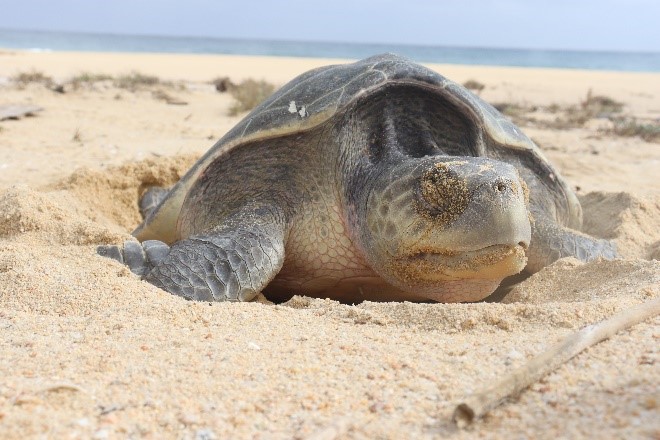SAVING THE SEA TURTLES OF LOS CABOS
Guests of Pueblo Bonito Resorts Aid Mother Nature to Protect Hatchlings
Los Cabos, Mexico (November 21, 2022) For nearly two decades, Pueblo Bonito Golf & Spa Resorts—now joined by Quivira Los Cabos—have aided a turtle protection and hatchling release program, boosting the survival rate of an endangered reptile that’s vital to the region’s ecosystem. But what happened last month was truly something special.
“The arrival of the olive ridley turtle occurs in Mexico on the Pacific coast, in the States of Oaxaca and Michoacán, and here in Baja California Sur,” explains Carlos Villalobos, manager of Pueblo Bonito’s Sea Turtle Protection Program. “What happened last month in Los Cabos in the Bay of Cabo San Lucas is surprising and fascinating. There is no record of this happening before, so it is a very rare event. Over the course of four day, hundreds of olive ridley turtles arrived at this beach to lay their eggs in a synchronized manner, both at night and during the day. We still have no scientific explanation for this event, which is known as an arribada (arrival by sea), but it surely has to do with the protection that has been given to the species for 20 years.”
After eggs deposited by the adult female turtles were retrieved from nests by volunteers and hotel guests who participate in our sea turtle program, they were quickly brought to the incubation hatchery, where they will most likely hatch in early December. There also are eggs from black and leatherback turtles, the latter growing to seven feet long and more than 2,000 pounds.
The release is sure to be quite a sight, thousands of hatchlings the size of a silver dollar scurrying across the beach to the sea. Easy prey for natural predators, these gentle reptiles need all the help they can get to reach the water, attain maturity, and increase their numbers. Guests of the resorts are able to witness these releases as part of seasonal programs that coincide with the sea turtle migration cycle.
Sea turtles contribute to both the beach and marine ecosystems in Los Cabos. They lay some 100 eggs in each nest, located in the beaches and dunes, with local plants using nutrients from the eggs to grow. and help anchor the dunes.
“The presence of turtles in the marine and coastal ecosystems where they live and reproduce is of vital importance for the life that develops in these places,” Villalobos said. “In nature, everything is related.”
For centuries, human demand for turtle meat, eggs, skin, and shells has reduced their populations. In addition, destruction of feeding and nesting habitats and pollution of the world’s oceans are taking a serious toll on the remaining sea turtle populations. The continuity of the species hangs in the balance.
Thanks to the efforts that have been made in protection and conservation programs, wonderful results have been achieved in favor of survival,” Villalobos said. “Not all species are threatened in the same way. We have the case of the leatherback sea turtle, the largest sea turtle in the world, which is in a critical state of extinction, so much so that some specialists believe that its extinction is imminent. In the case of the olive ridley turtle and the black turtle in Mexico, their populations are recovering favorably, but there is still a lot of effort to be made so that their populations recover to a better level. There is still the vulnerability of putting them back on the brink of extinction if we do not take the appropriate precautions in their conservation.”
For additional information on Pueblo Bonito Golf & Spa Resorts, their sustainability initiatives, and the sea turtle experience, access the website at www.pueblobonito.com.
